How to Network Your Way Into a Job at Google When You Dont Know Anyone
How to Network and Go the Task You Want
A stride-by-step methodology to take control of your job search and uncover opportunities you lot'd otherwise miss

In my professional life, I wear different but complementary hats. I am a headhunter, an associate professor of career strategy at IE Business organisation School, and an executive bus. And in all of my roles, I go along to accrue experience working with both students and executives who are looking for a new professional challenge, or transitioning to a new office.
From a personal perspective, I am also lucky to have experienced similar transitions beginning hand, through a non-linear xx-twelvemonth career in professional motorcar racing, investment cyberbanking, and entrepreneurship.
When dealing with professional person change, effective networking is the #1 most impactful activity. And the more challenging the move, the more disquisitional the role of networking is in securing the outcome.
Personal Contact Matters Now More Than Always
Today, information is available on a global scale. Submitting your CV online to a company with an open procedure is only the outset. The simply way to beat the competition is to pair process with action and to network your style to conclusion makers.
This applies to accomplished professionals too. In my coaching practice, personal branding and marketing are disquisitional areas of evolution for high-potential executives who are working on their biggest professional goals yet. Doing your chore and simply hoping information technology will get noticed is no longer an effective strategy. Nearly times, you need to brand sure it gets noticed.
Despite the fact that it's absolutely essential, reaching out to people we don't know remains the toughest high-touch activeness for virtually people to take.
Why? Because nosotros all have a psychological barrier when information technology comes to networking with those people. If you are someone in need, talking to someone with the power to make your 24-hour interval can be nerve-wracking.
Putting This Framework to The Test
Over the past 2 months, I have worked with many Masters in Finance (MiF) and MBA candidates on their approach to common cold networking. Their professional background is diverse, ranging from no experience or some internships to 7 years of professional experience.
What they all accept in mutual, regardless of feel, is how out-of-depth they experience when reaching out to people they don't know.
- Most of them reported feeling like they were wasting the other person'due south time;
- They felt out of control in the conversation, and often savage into the archetype "naught else to say, so what side by side?" trap;
- They were looking for a system they could script, one that motivated people to be helpful, but that also presented them every bit thoughtful and caring (instead of "needy").
Based on these challenges, we put together a simple process that has helped these students network effectively to secure an offer.
This procedure removes feet, allows you to regain command of the chat, and helps focus on volume and quality of interactions—not on getting immediate results out of each chat.
Let'south dive in!
Step 1: Mapping Your Network
Before we launch our outbound effort, it is imperative to map who we will be targeting. You lot may be reaching out to four unlike kinds of people, depending on how attainable they may exist:
- People you know: family unit, friends, and referrals
- People you lot just met (through networking events, etc.)
- People yous don't know, only with whom you have elements in mutual (university, school, town, etc.)
- People you don't know, and with whom y'all have nil in common
Interacting with people you lot know (ane) is relatively straightforward. The problem comes when seeking to follow upward with people we have recently met (2), or when establishing a human relationship with people we don't know yet (iii and four).
We will focus on cases 3 and 4 for the sake of this method, as this works all-time when there is little to no preexisting relationship. The process aims to convert people in groups iii–4 into people in group 1.
Pace 2: Getting People to Talk to Y'all
To get people you don't know to appoint with you lot, focus on three key aspects:
- Defining an inviting topic of conversation (the "agenda");
- Crafting a "first motility" email or LinkedIn message that gets a answer, and;
- Avoiding typical pitfalls that can put people off.
1. Defining an inviting "topic"
We can think of ii agendas when cold-calling or cold-messaging people:
- The "Large A" or big agenda: "I am looking for a chore."
- The "small a" or small agenda: "I am researching a certain job, a certain business firm or a sure partition."
Experience the departure? The beginning ane puts united states of america in a "needy" position. The second one volition assist with the end goal but comes through more agreeably.
On our first interaction with anyone, we should not go direct to the "BIG A." If you practise, the person you are networking with will experience defensive.
Put yourself in their position. Giving you a bit of my time is ok; asking me to endorse your candidacy by recommending your CV to HR when I don't know you is a much bigger—and also inappropriate—asking.
Focusing on "doing research" puts the other person at ease, helping them focus on what they tin can legitimately practice to be helpful. Don't underestimate how much people are willing to help others when the opportunity presents itself in the right format.
ii. The opening motility
Endeavour something like this:
"Hi, my proper name is Matt and I got your contact through [name/venue/schoolhouse/reference]. I am interested in investment banking as a career option and I am currently doing some research on corporate finance roles.
Would you have simply 7 minutes and then that I could enquire you 5 questions on the topic? It would really help me to learn more near the manufacture to develop a career in information technology when I graduate."
(After in this article, you lot'll larn all the details on how to ascertain these questions.)
Why does this pitch work?
- You are quoting the exact time the other person will invest in this practise. Visibility is soothing.
- You are simply asking for some information, not action nor endorsement.
- People dearest to feel relevant and talk about themselves. You are inviting them to practice that.
- You have exactly five questions, and it will take only seven minutes? I am curious. People have a matter for exact numbers and a well-constrained process.
- Yous encounter equally more thoughtful and considerate, instead of focused on immediate results or "using" the other person.
three. Avoid the typical pitfalls that can put people off
Besides not focusing on the BIG A, there are some no-get areas during your initial interaction. Do NOT practice any of the following:
- Send someone your CV before talking to them
- Ask someone to refer to your CV or application when you have not earned the right yet—they are not familiar with you and your work
- Brand the conversation all most yourself and what you need
- Wait or press for firsthand follow-up or value from the other person
- Ask shut-ended (yep or no) questions to the other person
- Come beyond as needy or slow; instead, strive to be curious and open-minded
- Focus on "selling" yourself
Pace 3: Following a Thoughtful Script
We said yous would only inquire five questions, so here they are:
one. Can you please tell me most yourself and why you chose to exercise what you lot did?
You open the conversation by request the other person virtually their arroyo to crafting their career. Why this task? What other options did they consider? What academy or degree? This information provides united states of america with input about their determination-making process and intention.
2. Can you tell me about your company and your chore, and the mean solar day-to-day?
We follow with a question about the job, the manufacture, the company, or their career projection. Nosotros shift from the individual to work itself.
You may have noticed that nosotros are not opening the conversation by talking well-nigh ourselves. This is intentional: anybody enjoys talking about themselves, then nosotros apply this to go the other person engaged. I call this the "ego" function.
3. What are the things you lot didn't know that you didn't know when yous were applying, and when you started (this is, what blind spots did you lot take when you started that you uncovered over fourth dimension)?
Key question.
Once the person is ready, nosotros play an "equalization" game. When anyone is giving you advice, they do and so from a "higher upwards" position. By asking this question, you are forcing the other person to "step down" and think of that time in which they were in your position.
4. How would you approach the next steps in my research, if you were me? (A more direct version of this would be "if I was your brother or sister, what would yous recommend I practise next?")
Nosotros are now asking the other person to belong themselves emotionally with our process. At this stage, you may go the person to offer their explicit help with your Large A without you lot fifty-fifty asking. If you don't, no worries. They may give you a few useful tips to go along your enquiry anyway.
Questions three and 4 are the "empathy" part. We are encouraging the other person to meet usa at our level and to invest themselves in our long-term need (Big A) without even mentioning it. By asking them to recall their ain ancestry, they can empathise with yous more than, and the chances of getting the help y'all demand increase dramatically.
And now, to the closing motility:
5. Is there anyone else you could recommend I speak to, in society to continue with my research? Is it ok if I mention y'all when I reach out to them?
This is the master goal of the phone call for u.s.a.. We do not get out the conversation without a new name to continue with our research.
This is key:
- By doing this we are, again, offering the other person to accept the initiative and aid usa beyond the name dropping itself. But even if a proper name is all we get, that is already a success.
- The idea here is to build a network of interlinked people. At some point, it is likely that we volition find someone that either has an opportunity for us or volition take the initiative to help us.
- If yous get 5 people to provide you two names each, y'all can already follow upwardly with ten people you did not know earlier, already continued to someone you already know. If those ten people practice the aforementioned for you lot, you will have a list of 35 connected people in 2 rounds. You will be building a great network that is leveraging itself at each footstep.
- If the other person offers to introduce you to their contact, bully. Only don't ask for it. But enquire for permission to mention your contact'south proper name when you attain out to the side by side person. (Yous volition be able to look the new names up in LinkedIn.)

So, the terminate-to-finish procedure looks like this:
- Mapping your contacts: approach at least three people at each institution relevant to your recruiting attempt.
- Sending your pitch: LinkedIn messaging works great (and yous may want to consider paying for premium features for as long as the process goes on).
- Following the script — have it written in front of you lot. Don't leave anything to run a risk.
- Following up with the new names you get from your interactions.
- "Rinse and echo:" following up with anyone willing to help beyond the initial interaction.
Step iv: Doing The Work
Have some pressure off yourself: virtually interactions will not yield whatsoever directly results. And knowing this beforehand can assist u.s.a. focus on the process, instead of obsessing with the result of each interaction.
In my experience, networking for a job is a 20 to 1 game: 20 interactions will result in v meaningful conversations, which will then lead to ane or 2 individuals doing something tangible to help you. If you are non doing this repeatedly, it is unlikely that, statistically, y'all will succeed. The volume of interactions is the cardinal.
If getting the job you desire is a priority, treat this networking procedure every bit a priority, too.
I always enquire the following question: how important is getting the job to you? 90% place "getting the offer" at the top of their list.
So then, if this is your superlative priority, are you blocking out time in your agenda every week that is aligned with the importance of this outcome?
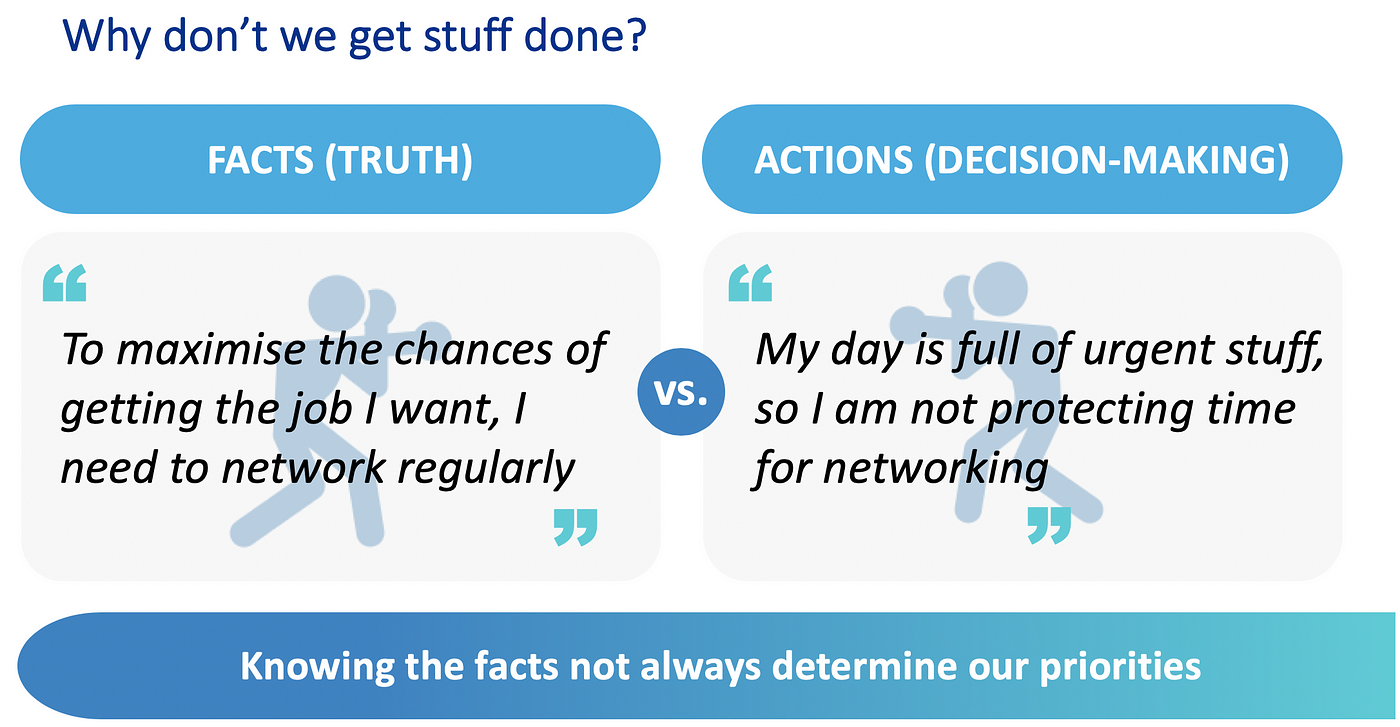
The truth is this: if y'all are non blocking at least 3–v hours per calendar week to this procedure, so getting an offer volition be an uphill boxing.
How can we link determination-making to the end goal?
By not relying on willpower, but past designing a process. Try blocking predefined slots in your calendar, and care for those as medical appointments. Focus on each day, each interaction, and go through the list. Let the process drive you to the ultimate goal: an offer to do the task y'all want.
Top 5 Questions Raised by Students Using This Framework
1. "At which point can I talk almost myself?"
Probably between Q2 and Q3. Or even ameliorate, whenever the other person asks you to practice it. At that point, they are prepare to listen.
2. "How tin I trigger a follow-up interaction?"
You lot could end wrap up saying — "Would it be ok for me to go along you posted with my progress?" The key affair is to earn the right to follow up.
3. "When is the right time to motility from the "pocket-size a" (doing my research) to the "Big A" (getting a job)?"
When you get a hint by the other person, or when you lot have had a couple of chats, and you experience that they may be supportive. There is no rule for this; y'all volition take to judge the energy of the meeting. Moving people is not an exact science, but an "art". Remainder bodacious that exposing your contacts to this framework is a peachy manner to open the dialogue.
4. "What if they practice not want to requite me a name? What if they exercise not want to help?"
Bad luck; we focus on the adjacent contact. Focus on the process and not on obtaining immediate results. Again, information technology'southward a numbers game. Some people will never help you, no affair what you lot effort. Exist at peace with this fact and move on.
v. "I tin't put it in practice if the other person does not agree to get on the phone. What at present?"
Good question. It comes down to the option of your initial batch. You lot may not know them personally, only y'all can endeavor and option people that yous have something in common with. It volition exist easier if you lot attended their aforementioned school or university, or if you share a passion for the same sport. People tend to look for points of reference, so give them one, and the initial approach may prove a lot easier.
Testing The Effectiveness of This Approach
Since whatever method is judged upon its results, I ran a survey amidst the students that had worked with me using this arroyo during the past few months.
In total, 25 individuals contributed with their input — these are the questions surveyed and the aggregated responses:
one. How many people did you contact in your initial effort with this technique (your initial list)?
Respondents reached out to between 5 and 15 people in their initial endeavor.
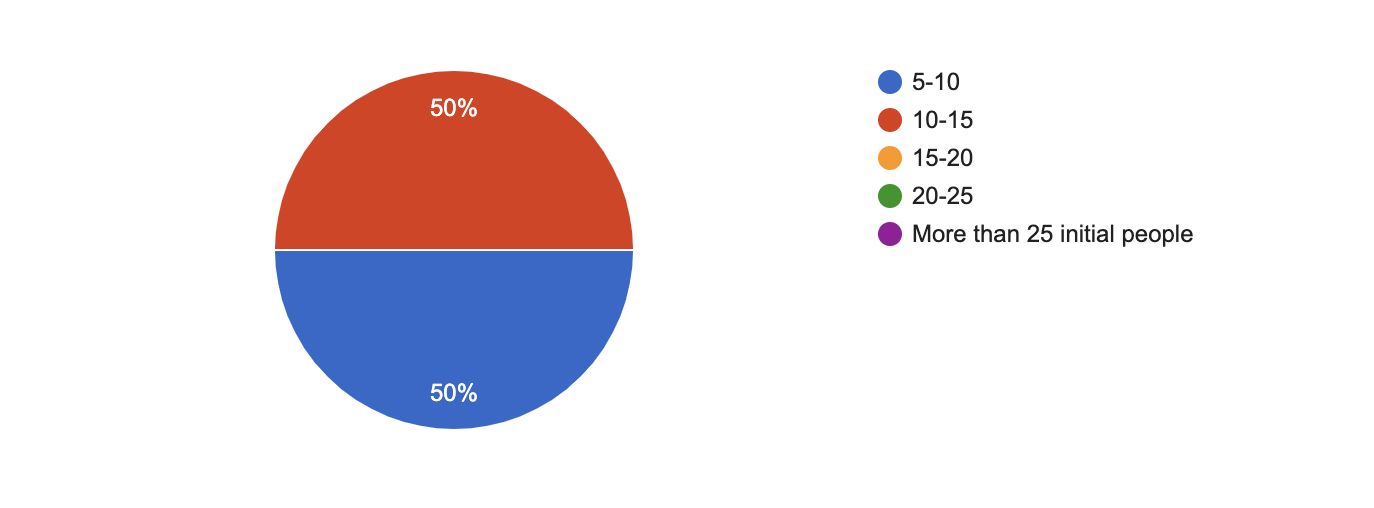
2. How many people have you been able to reach, eventually, using this technique?
And then far, this framework has immune students to extend their network, reaching upwardly to 30 people in some cases.
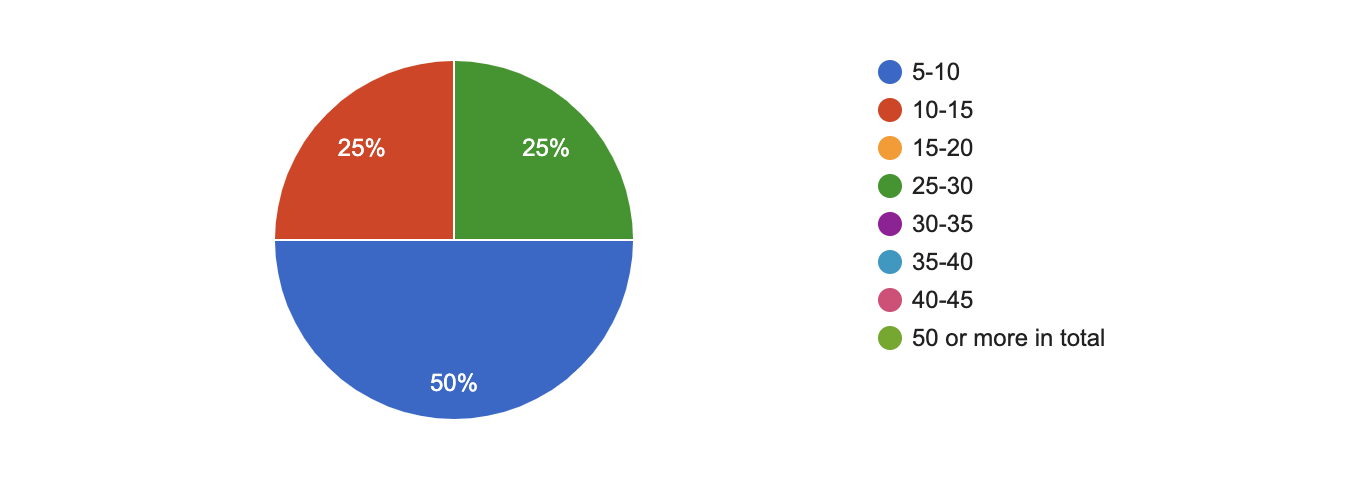
three. In which ways accept you adapted this technique to your particular way?
These are a few replies:
- "I tweaked the script slightly to fit it to my personality."
- "I've tried to become from LinkedIn messages to alive 1-on-one's as quickly as possible given that I am more comfortable with in-person meetings."
- "I have started attention networking events and then using this framework with those with whom I have interacted live at the issue."
4. Did the technique make networking easier, make you feel safer, and/or make you feel more in control when reaching out to people you did non previously know?
A "thumbs up" to the effectiveness of this framework when it comes to feeling more in control and getting more out of the interactions with unknown people.

v. Did people get more open and/or more than helpful since you lot started implementing this tactic? Would you recommend this technique to others?
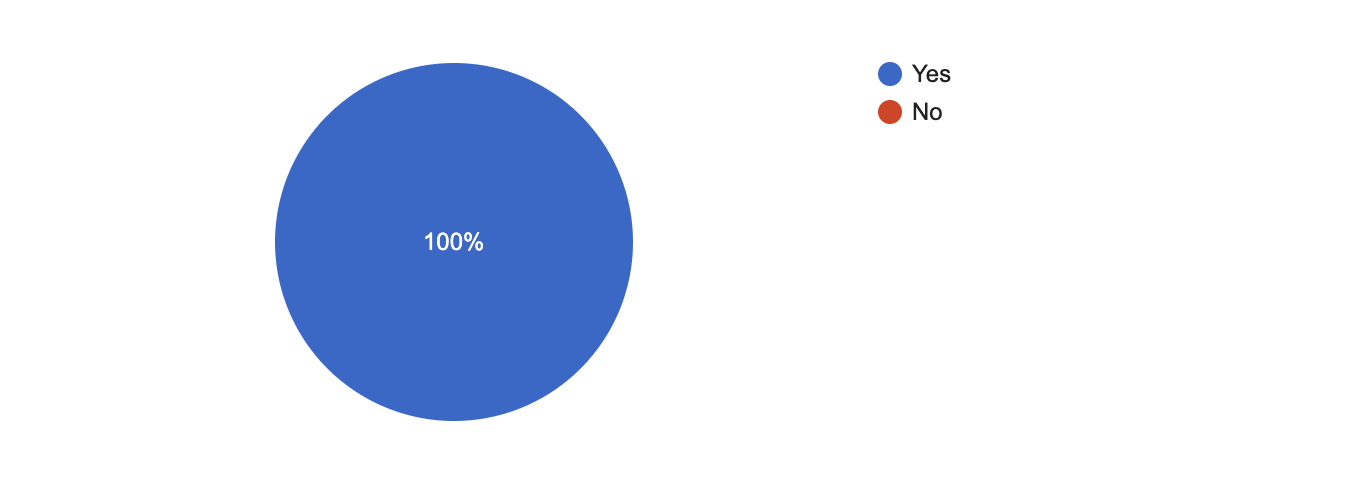
6. If y'all responded "yes" to the previous questions, can yous describe how this technique made networking easier for y'all?
- "You get a more positive response from people."
- "Having a template makes everything a lot easier."
- "It made me realize that cold calling was actually fine."
- "I discovered how powerful cold calling can exist. It wasn't something I was doing a lot of earlier."
- "It allows you to drive the conversation and puts you in control."
- "Information technology helped me expect insightful instead of nervous."
half dozen. Are you lot booking time in your calendar for weekly networking?
Those getting ameliorate results were those that treated networking as yet another priority in their weekly calendar.
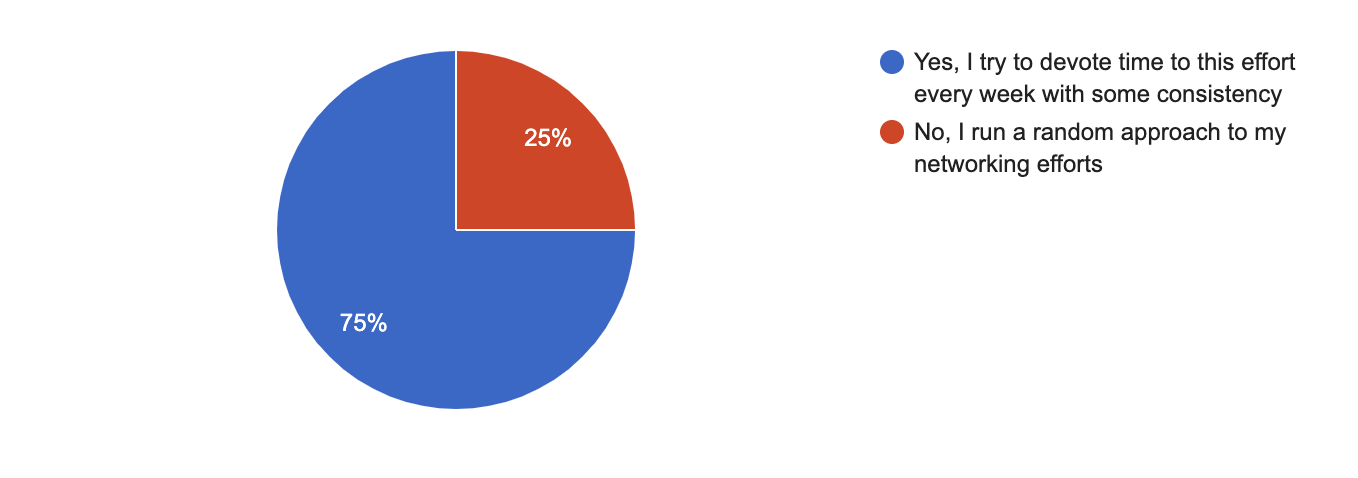
7. How many job interviews did you get since yous started implementing this technique?
The jury is however out in terms of final offers (the recruiting season is nonetheless ongoing), but candidates applying this framework made noticeable progress.
All respondents progressed to at least i interview after applying this framework; 25% of them got two then far.

Determination — A System That Works
This system allows y'all to leverage your network. Small initial numbers can abound to hundreds of people over a few weeks of consequent work.
Past talking to people referred to y'all by others, you will terminate up getting out of the established recruiting circuit. You lot volition uncover opportunities that may not exist out to the general public. Bear in mind that sometimes people rent people that they know, or that come from trusted sources with robust references.
The scripting helps you take pressure level off the firsthand result and focus on long-term affect. Desperation and anxiety brand for terrible marketing. Y'all will feel secure and in control, assuasive you lot to be your best version when it matters nearly.
You will come across as someone hirable: thoughtful, with a well-designed procedure and with a focus on effective execution. All are coveted qualities in any professional role.
Serendipity happens when you lot leave little to luck — so that luck can come up to the rescue when needed. So become on with your goal; stop contemplating your LinkedIn contour, and start making the connections that may change your life forever.
👉The Better Humans publication is a part of a network of personal development tools. For daily inspiration and insight, subscribe to our newsletter, and for your most of import goals, observe a personal coach.👈
Source: https://betterhumans.pub/how-to-network-with-people-you-dont-know-to-get-the-job-you-want-7feee9474d40
Post a Comment for "How to Network Your Way Into a Job at Google When You Dont Know Anyone"